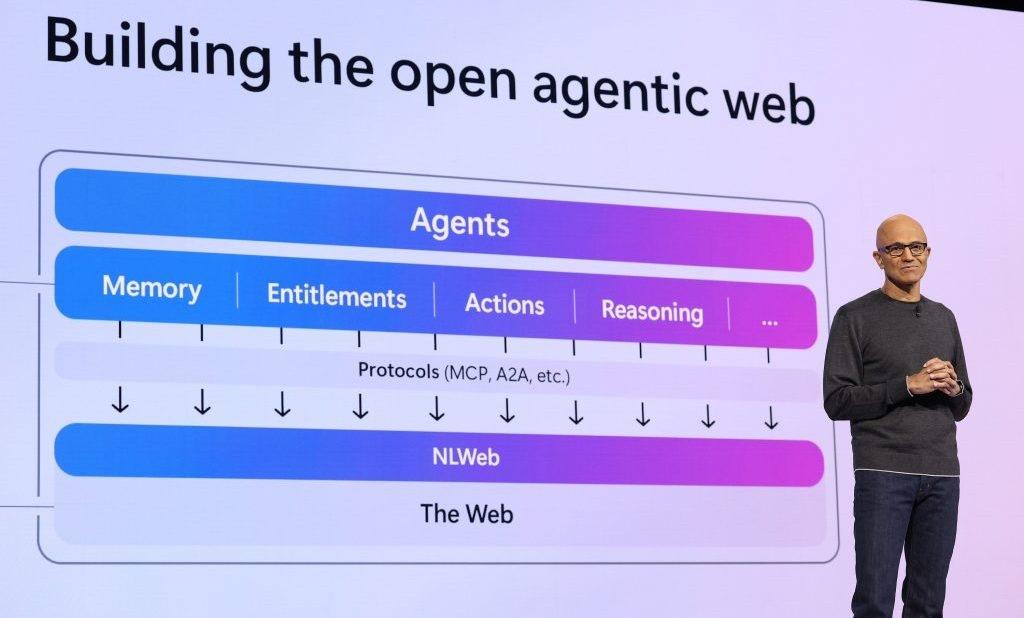Microsoft CEO Satya Nadella on stage at Build 2025
A year after Microsoft launched the Copilot+ PC, we’ve finally started to get an idea of what’s possible with an on-device NPU and Microsoft’s fully featured, AI-enhanced OS. Microsoft suffered a major false start with its Recall function, but now that we’re a year past the initial launch, all three major silicon vendors have support for Recall, among other AI-enhanced features.
But we’re still lacking many of the third-party developers building on top of what Microsoft has enabled in Windows 11 — which is needed to make it a truly AI-accelerated experience that fully leverages the NPU. The Microsoft Build 2025 conference made more moves in that direction with a slew of new announcements to help propel the industry and the Windows ecosystem forward.
(Note: Microsoft is an advisory client of my firm, Moor Insights & Strategy.)
New AI Features And Tools
Microsoft has evolved what was previously called the Windows Copilot Runtime into the Windows AI Foundry. At the heart of AI Foundry is Windows ML, an evolution of DirectML that was previously the center of the Copilot Runtime. Microsoft says that Windows ML enables developers to “bring their own models” and deploy them efficiently across the complete ecosystem of silicon vendors. The company is also saying that WinML will not only support Copilot+ PCs but also the full breadth of PCs, from entry-level laptops to high-end AI workstations, using whatever silicon is available for AI acceleration.
Microsoft also announced that it will embed Anthropic’s open source Model Context Protocol and the Agent2Agent Protocol into Windows and other Azure offerings; these protocols create a standardized framework for AI agents to interact with apps and services. Microsoft also announced a new open source project called NLWeb, which looks to extend agentic user experiences into the internet, bridging some of the gaps between the cloud and local devices.
I applaud this much broader approach from Microsoft, although I also believe that it creates an even heavier lift for for the company. Still, it should allow for AI features to run on way more PCs. Microsoft’s story is shifting away from NPU-only acceleration towards talking more about the GPU and CPU as well. However, the Open Neural Network Exchange AI runtime is still at the center of the Windows ML runtime, which means that there might still be some performance left on the table in the name of ONNX compatibility.
That said, some vendors have said that Nvidia’s new WinML TensorRT EP is two times faster than its previous Direct ML implementation. I believe that this is the approach that Microsoft should’ve taken from the beginning, but I’m not sure that the software and hardware ecosystems were quite ready to deploy such a solution. In the end, anything that makes it easier for developers to roll out AI capabilities independent from the AI hardware on the device is a net benefit for the ecosystem and the broader industry. I’m glad to see the Copilot Runtime has evolved into something that developers can actually use — and that stands to make it easier to manage the complexity of four different silicon vendors all with different CPU, GPU and NPU architectures capable of AI.
New Microsoft Developer Tools
WSL — the Windows Subsystem for Linux — is now open source. While WSL was launched in 2016, it has steadily grown in popularity among developers wanting to run Linux code on Windows without needing to spin up a virtual machine environment. WSL 2 further grew its popularity when it launched in 2019, but some fundamental capabilities were still not available. One of the first requests from the developer community was to open-source WSL to make it easier for developers to use. I believe that finally doing this will simply make Windows an easier platform to develop for and encourage more developers to use it.
Microsoft also launched its new “Advanced Windows Settings,” which was previously called “Windows Settings for Developers.” This new version gives users, whether they are developers or not, more control over how folders and files are displayed and how version control works. Microsoft says that the new Advanced Settings page has been open-sourced on GitHub and can be maintained via its Windows Store. The Advanced Settings feature manages not only File Explorer, but also Virtual Machines, which is why it used to be called “for Developers” — since those features are predominantly used by developers.
Microsoft Store Update
Microsoft wants to continue to grow the Microsoft Store, which is now used by more than 250 million monthly active users, so as one of the first steps it is enabling free account registration for individual developers. This previously required a $19 fee — which will still be charged for companies — but eliminating this fee for individuals could enable younger developers to create apps without that barrier to entry. Microsoft also has a new Store FastTrack program for companies to help them submit their apps to the store more quickly, including waiving the $19 fee.
Microsoft is also committing to faster and more transparent certifications for the Store to enable faster turnarounds, clearer guidance and fewer resubmissions. Microsoft also announced that it is making discovery better with enhanced Windows and Store search, which should make it easier to launch apps that users already have installed. I personally hope this gets smarter and more accurate because I launch most of my apps through search, usually not even fully typing the name of the program. Microsoft will also enhance Store search with more intent-aware search, using vector embeddings and semantic ranking for better results.
Analyst Takeaways
I believe that Microsoft continues to move in the right direction with both open source and AI on Windows. The Windows Copilot Runtime simply wasn’t getting the traction that I think Microsoft needed for success, and it’s clear that the company has listened to both hardware and software vendors to create WinML and the AI Foundry. WinML and the AI Foundry seem to be better positioned to enable local AI-accelerated applications and finally deliver a lot of the promises of the AI PC.
With the AI space moving at breakneck speed, it’s good to see that Microsoft is making the necessary adjustments to ensure that the Windows platform doesn’t get left behind. Microsoft should be working in lockstep with the ecosystem to enhance the Windows and Azure environments for AI use cases, but I do believe that Microsoft still has the best opportunity to take advantage of productivity in AI with Windows and its suite of apps. I also believe that Copilot should be more at the center of the Windows experience, but with virtually no desktops supporting Copilot+ features, it feels somewhat disjointed. I also believe that Copilot should be integrated more deeply into Windows and should be able to run (with obvious limitations) locally without an internet connection. Time will tell whether Microsoft moves in that direction.
Moor Insights & Strategy provides or has provided paid services to technology companies, like all tech industry research and analyst firms. These services include research, analysis, advising, consulting, benchmarking, acquisition matchmaking and video and speaking sponsorships. Of the companies mentioned in this article, Moor Insights & Strategy currently has (or has had) a paid business relationship with Microsoft and Nvidia.





